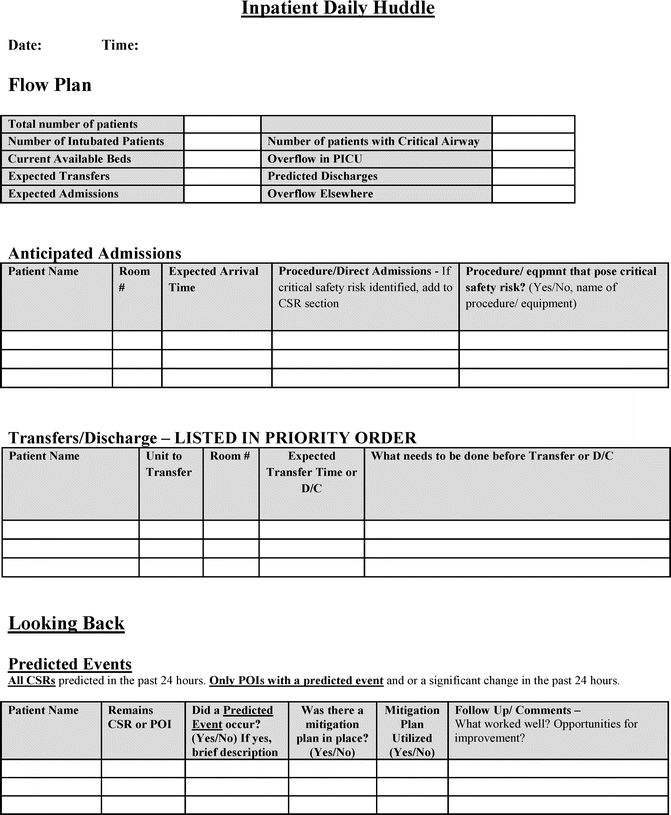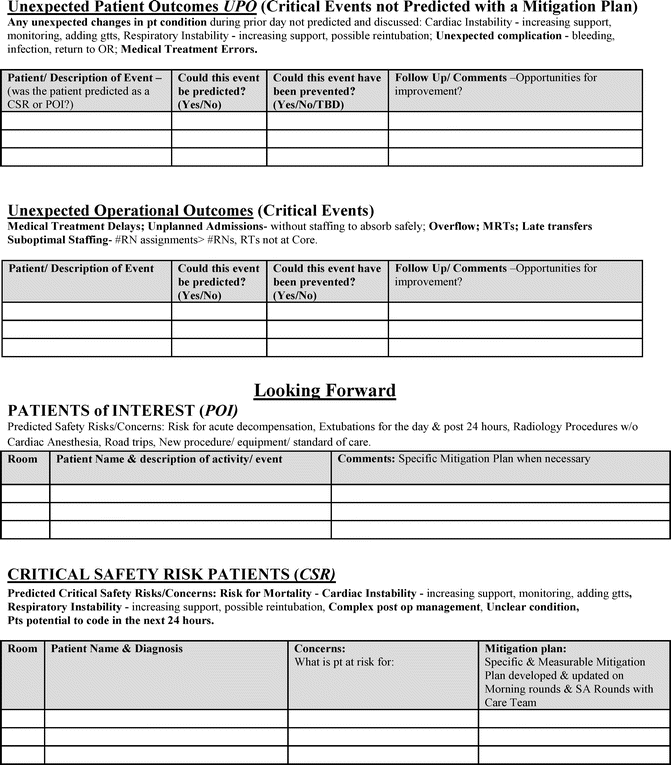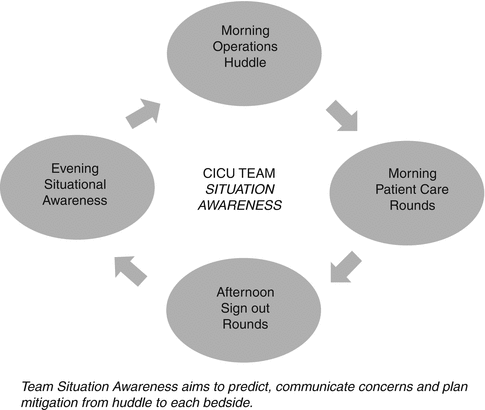Fig. 6.1
Identify, mitigate, and escalate model illustrates which risk factors were systematically identified and how standardized communication about risk occurs throughout Cincinnati Children’s Hospital Medical Center. Reproduced with permission from Pediatrics, Vol. 131, pages e298–e308, Copyright (c) 2013 by the AAP
Utilization of SA systems in the CICU environment has been limited. Reader and colleagues reported a system to assess the SA of an ICU team and observed that members of the team formed conflicting anticipations regarding the likelihood of patient deterioration [15]. The SA systems utilized in general care units could be generalizable to most inpatient healthcare environments, including the ICU. Although ICUs are typically considered high acuity environments with patients at risk for further clinical deterioration, failure to recognize acute decompensation in patients can lead to serious safety events. In order to recognize patients at highest risk for clinical deterioration or mortality, SA techniques could be utilized to proactively identify patients at highest risk for deterioration and mitigate potential acute events. As noted by Reader and colleagues a key goal of the ICU team is to create a shared mental model of the patients’ status. Similar to Brady and colleagues identification system, criteria to identify those ICU patients at highest risk for deterioration would foster better SA among members of the ICU team [15].
Instituting principles of high-reliability over a 24 hour span assures more consistent communication of SA within a CICU care team. Conducting a quick 10 min unit huddle prior to morning rounds offers an opportunity for the clinical care team to generate an emerging shared mental model for the identified-at-risk patients they are caring for over the next shift. The lead physician and charge nurse facilitate the huddle to foster a partnership between physicians and nursing. Creating consistent, scripted processes when facilitating huddles and rounds can lead to more timely discussion and clear communication of plans reducing unnecessary delay when emergent treatment is necessary [16]. During the huddle the team reviews the previous 24 hours discussing predicted events, mitigation plans utilized and unexpected patient and/or operational outcomes (complications, medication errors, equipment issues, inadequate staffing) (Fig. 6.2). Identifying and reviewing safety events provides timely awareness and appreciation of system issues. To foster team SA, the team would discuss plans for the next 24 hours, focusing on the patients most at risk for deterioration or adverse events. Potential topics for the huddle might include: census review, admissions, transfers, discharges, surgical and medical procedures, patients at highest risk for acute events, infection patterns in the ICU and the mitigation plans.




Fig. 6.2
Cincinnati Children’s Hospital Medical Center Heart Institute Inpatient Huddle Model
Morning care rounds are an existing system that could be utilized to foster SA of the CICU team. Implementing new processes in existing systems leads to higher reliability. During morning care rounds, the entire care team gathers to plan the care for each individual patient. Embedding SA into rounds discussion could stimulate a shared mental model for the patient’s plan of care. For example, the provider could initiate a time-out for safety, explaining the specific mitigation plan for the identified risks when concluding the patient’s plan of care. Clear communication of a specific plan of care may enable timely interventions to reduce the possibility of severe cardiopulmonary decompensation. Creating additional SA opportunities is essential to assure utilization of mitigation plans and the sustainability of a shared mental model across the 24 hour span. A huddle at the time of nighttime handover presents another opportunity to briefly review the identified high-risk patients and their mitigation plans to ensure a shared mental model. Acute events such as cardiopulmonary resuscitation are equally common during night shift hours in an intensive care unit. During the night shift, availability of clinicians to respond to acute events is reduced. Instituting SA efforts during the night shift hours has tremendous potential to prevent serious patient safety events. By establishing evening SA rounds, the shared mental model for high-risk patients and their mitigation plans can be communicated, allowing for an ongoing shared mental model of patient care. The model illustrated in Fig. 6.3 demonstrates the key SA touch points throughout a 24 hour time period.


Fig. 6.3
Model of team situational awareness over a 24-hour period
Situation awareness in a CICU can generate significant clinical impact. Since episodes of clinical deterioration can exacerbate organ system injury and increase patient length of stay, early recognition can prevent increased morbidity, delay ICU discharge and eliminate unnecessary costs. Establishment of a CICU situation awareness model may improve patient safety, clinical outcomes and the overall patient experience.
Performance
Health-care providers share a common goal – providing high quality care to their patients. Measuring performance can help one understand how well your team is accomplishing this goal. It allows for an analysis of where and what changes need to be made in order to improve performance and the quality of care provided. Measuring performance also allows providers to reflect and consider what is working well; information that can be shared with other providers who can learn from their success and failure. Performance measurement is the regular collection of data to assess whether the correct processes are being performed and desired results are being achieved [17]. It analyzes the success of a team, program, or organization’s efforts by comparing data on what actually happened to what was planned or intended. The focus of performance measurement is less on the individual provider and more on the team as a whole to evaluate whether an adequate structure and correct processes are in place to achieve the stated goals.
Avedis Donabedian, an influential leader in the study of health care quality, developed a widely used, three-element model of quality measurement in 1966, which included measuring health care structures (the characteristics associated with a health care setting), processes (the activities done in a health care setting), and outcomes (the results achieved for a patient after a given set of interventions) [18]:
1.
Structural measures include requirements imposed by payers and regulators, such as specifications for the facilities, management systems, health IT systems, board certification, and staffing ratios. Examples of structural measures include physician staffing, computerized physician order entry, pharmacist participation during rounds, rate of unplanned CICU readmission and cancelled OR cases.
2.
Process measures determine whether evidence-based care guidelines were followed, but do not indicate whether a patient’s health actually improved. Process measures, in essence, are used on the assumption that better outcomes should result from evidence-based care processes. Examples of process measures include rates of unplanned extubation, nutrition support, multidisciplinary daily rounds, effective assessment of pain, appropriate use of blood transfusions and appropriate gastric ulcer prophylaxis.
3.
Outcome measures seek to determine whether the desired results are achieved. This could include whether the patient/family was satisfied with the care received. Examples of clinical outcome measures are catheter-associated bloodstream infection, CICU mortality rate and patient/family satisfaction.
Additionally, the team usually identifies a balancing measure to ensure that changes to improve one part of the system are not causing new problems or unexpected consequences in other parts of the system. The next step is to use the information to measure performance and improve care. Performance measures provide a picture of the team’s quality, but further investigation is necessary to determine the factors that influence the measure results and how you can learn from positive results and make changes where performance is not at an optimal level.
Performance management is when a team uses performance measures and standards to achieve desired results. It is a forward-looking, continuous and purposeful process. This practice involves strategic use of performance measures and standards to establish performance targets and goals. Performance management practices can also be used to prioritize and allocate resources; to inform leaders about needed adjustments or changes in policy or program direction to meet goals and to frame reports on the success in meeting performance goals. Performance management includes the following components [19]:
1.
Performance standards – establishment of organizational or system performance standards, targets, and goals to improve public health practices.
2.
Performance measures – development, application, and use of performance measures to assess achievement of such standards.
3.
Reporting of progress – documentation and reporting of progress in meeting standards and targets and sharing of such information through feedback.
4.
Quality improvement – establishment of a program or process to manage change and achieve quality improvement in programs or infrastructure based on performance standards, measurements, and reports.
Performance improvement requires substantial investments in the underlying science of measurement, transparent communication of measurement results, attention to the role of measures in quality improvement efforts, and using performance data in focused and strategic ways [17].
Competency
Pediatric cardiac critical care has undergone tremendous growth and expansion over a short period of time. The growth of this field has paralleled expansive growth in general pediatric critical care over the same time period [20]. Over the past 20 years, pediatric cardiac critical care has developed into a robust clinical, scientific and research entity and, as a result, a well-recognized subspecialty within pediatrics. As surgical techniques and management have advanced, survival in infants and children with congenital heart disease has improved [21], and greater emphasis has been placed on the reliability of care in the intensive care unit. Increasing attention is being paid to optimizing outcomes, preventing harm, and delivering safe and cost-effective care rather than simply preventing mortality.
Training
The need to ensure appropriately trained staff to care for these complex patients has been scrutinized and debated. As surgical techniques have advanced, so too has the complexity of patients cared for in the cardiac intensive care unit. Pushing the surgical envelope has demanded more from the postoperative care team; however, the best training for the physicians and other team members responsible for the care of children in the cardiac intensive care unit remains unclear.
While some have argued that patients in the pediatric cardiac intensive unit are best taken care of by critical care trained providers [22, 23], care models for children with critical cardiac disease vary greatly across the United States [24]. Guidelines for pediatric cardiovascular centers set forth by the American Academy of Pediatrics (AAP) stipulate the need for dedicated space in either a specialty cardiac intensive care unit, or a pediatric or neonatal intensive care unit prepared to offer comprehensive care to the postoperative patient. The AAP recommends that the cardiac intensive care unit patient should be cared for by surgeons, intensivists and cardiologists [25]. However, comparison of outcomes for patients cared for in a dedicated cardiac intensive care unit (closed) to those cared for in other non-dedicated and open intensive care unit care models demonstrated no difference in postoperative morbidity or mortality [26]. According to the American College of Cardiology, American Heart Association and American College of Physicians Task Force on Clinical Competence, board eligible/certified pediatric cardiologists require at least 9 months of additional advanced training to be primarily responsible for the comprehensive care of children with critical congenital or acquired heart disease [27]. Training and proficiency is needed in many aspects of critical care including mechanical ventilation, invasive procedures and management of multi-system organ failure [27]. While the skills specified are largely inclusive of the care and knowledge needed to care for critically ill children with heart disease, specific measures of competency are not documented and there is no standardization of the training elements.
There is evidence that 24-hours care by trained pediatric intensive care providers decreases the duration of mechanical ventilation and intensive care unit length of stay [28]. Data such as these support the concept that the skill set of the providers are likely more important than the training path taken to acquire those skills, and research in adult critical care has shown that the base subspecialty training does not impact outcomes [29]. Rather than focus on the training background of the physician, emphasis should be placed on the competency and quality of care delivered by the teams managing critically ill children with heart disease.
Assessment of Competency
The diverse training background of physicians delivering care in the cardiac intensive care unit makes the assessment of competency challenging, and the lack of standardization in training contributes to difficulty in defining appropriate competencies. The absence of standardized competencies has led to the development of scoring systems to assess outcomes and the performance of the intensive care unit as a whole. The Pediatric Risk of Mortality (PRISM) III scoring system assesses mortality risk based on physiologic variables within 12 and 24 hours of admission and has been validated as a discriminatory tool to assess the mortality risk [30]. However, the PRISM III scoring system is not designed specifically for children with heart disease and does not take into account provider variables. Similarly, the Pediatric Index of Mortality score (PIM) II assesses mortality risk at the time of intensive care unit admission [31], but is not dynamic and also has similar shortcomings to the PRISM III score.
Two validated surgical complexity-scoring systems include the RACHS-1 scoring system and the comprehensive Aristotle score, both developed specifically for children with congenital heart disease undergoing cardiac surgery [32, 33]. The Aristotle score was developed with the idea that perhaps performance is a function of complexity. Child survival where complexity is a constant is based on the lesion and operation to be performed. Survival then is dependent on performance which is measured as Performance = complexity × survival [32]. While the Aristotle score introduces this interesting concept, we are still without a means to assess performance. If a patient has a low-risk lesion and an uncomplicated operation with an experienced surgeon yet suffers a bad outcome, does this reflect the poor performance of the cardiac intensive care unit physician or the surgeon or the entire team? Any assessment of competency and performance must ideally be linked to patient outcomes while under the care of a specific provider or providers.
< div class='tao-gold-member'>
Only gold members can continue reading. Log In or Register to continue
Stay updated, free articles. Join our Telegram channel

Full access? Get Clinical Tree


